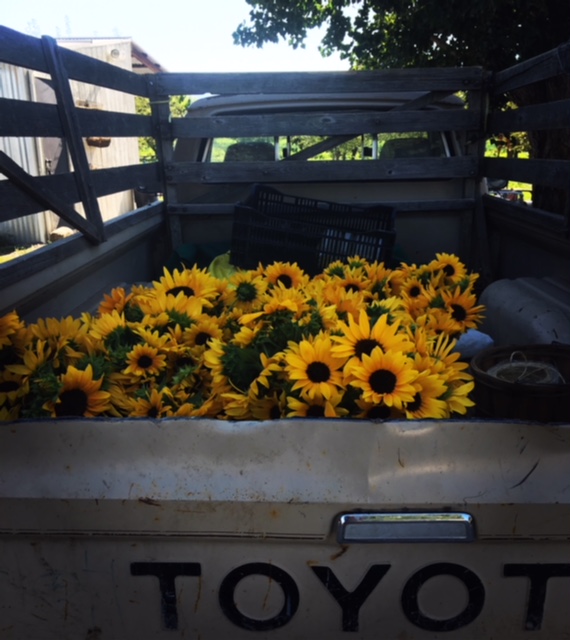Hakurei turnips. Aka Tokyo Roots Would you be willing to play around with this ingredient?
Remember the saying: “You get what you get and you don’t throw a fit?”
CSA members have to learn to be flexible with their menu and make things work in the kitchen, because you often don’t know what you will get in your box until a few days before the pick up.
Some people love this spontaneity. Others will be stressed by it.
Think hard on this:
Are you willing to give up some control over what goes in your box? Or do you need to live by yourplan?
If you’re someone that wants to have spinach lasagna on Wednesday, and your box doesn’t have spinach that week, will you be upset that you have to go elsewhere to supplement your CSA box contents?
If so, then you may be better off buying from the grocery store or farmer’s market retail stands.
This is the number 1 reason non-renewing members give us for leaving our CSA:
“I didn’t get enough of the things I wanted, and I got too much of the things I didn’t.”
CSA works best for customers who see their kitchen as a creative space, and our vegetables as the “paint” for their canvas.
They can handle the spontaneity required and are willing to experiment with new ingredients to make old meal templates come alive in new ways.
Our CSA provides a roadmap to help you “master” eating the CSA way. But it takes time.
Q5: Are you willing to work at eating the CSA way? Patience, my apprentice. (It’s a marathon, not a sprint to the finish line).
CSA takes time to see results. We have customers that have been with us for over 5 years, and they all say it took about 2-3 years before they learned how to consistently use the box’s full contents.
That means you will waste some food on the front end, as you go through your learning curve.
Come into this experience with an adventurous spirit, and go easy on yourself if you fail to eat the entire box every week at first. It’s really hard to do, especially as a rookie to the system.
There will be many weeks when you have best intentions to be a super-chef and maximize your CSA tasting experience… and then real life sets in, and you find yourself simply eating the broccoli raw with ranch dip.
It can sometimes feel like you’re “failing” in your original goal to change the way you eat.
Realize that if this is your goal, it takes time to learn the skill sets. (Don’t worry, we’ll teach them to you). Set realistic goals the first year, and work your way into it.
Also realize that in this journey to kitchen mastery, you’re going to waste some food, especially in the first learning year.
This is a really hard reality for some to face.
Either you don’t get home to make dinner in time because your life is hectic (so the veggies rot)…
…or you end up eating take-out several times a week because you’re playing chauffeur to your 3 kids (so the veggies rot).
Like all paradigm shifts, it takes time to develop new habits and learn how to eat nimbly.
If you are committed to learning how, you can do it!
But it may take a few seasons before you feel like you’ve got it down.
Do you have the staying power to “work” at CSA?
Q6: Are you looking for a “deal”? Are you comparing CSA prices to the grocery store?
CSA members tell us that their kids are now eating vegetables.
People who fully embrace the CSA model don’t look for their membership to be a “deal” or a bargain.
And they don’t compare the CSA experience to the grocery store price table.
Read that again. This is a really key point.
It is absolutely understandable to ask, “How much does it cost?” And to then weigh the pros and cons.
Supporting a CSA financially however is not just about doing a cost analysis of each vegetable you receive in your box and comparing it to what you’d pay at Kroger or Costco.
Our vegetables have added value because every one of our vegetables is telling a story.
Not just the story of how the food was raised, how it was harvested, or what struggles it faced to come to your plate.
Not just the story of the farmer and how you help them live out their calling to the land.
EVERY VEGETABLE IS ALSO TELLING YOUR UNFOLDING STORY.
Our vegetables become a means to an end: they showcase your journey with food.
They are the starring attraction in your quest to master your kitchen space and prepare a delicious meal to rival any restaurant fare — a meal you can be proud of.
This is not something any grocery store can give you.
CSA customers appreciate this added value of our product, and are willing to pay a premium for it.
So if you’re saying to yourself, “Well that’s more than we’d pay at _____” ~ you may want to hit the pause button.
Just sayin’…
How’d you do?
Did you pass the quiz?
Remember, CSA is just one model out there for getting fresh farmer food onto your table. For those who value the story, the journey, and the farmer relationship behind the food, it can be a great option that can change the way you eat forever.
But there’s no shame in passing on CSA and instead buying weekly from a farmer’s market.
And that may in fact be a better fit to your style or needs.
We do both, so we just want you to be in the right fit.
As in all things, expectations determine how you experience the product. To set you up for CSA success, make sure your expectations align with the philosophy of CSA before you commit.








































![21078281_1498595576866863_1358147166165797015_n[1].jpg](https://images.squarespace-cdn.com/content/v1/5289a794e4b09729787489ad/1607463086803-TZK7Q62H05MC6Q2BMVG1/21078281_1498595576866863_1358147166165797015_n%5B1%5D.jpg)

![IMG_6725[14939].jpeg](https://images.squarespace-cdn.com/content/v1/5289a794e4b09729787489ad/1597069602637-5CO6KOJLP4I5O16CZ23J/IMG_6725%5B14939%5D.jpeg)


















